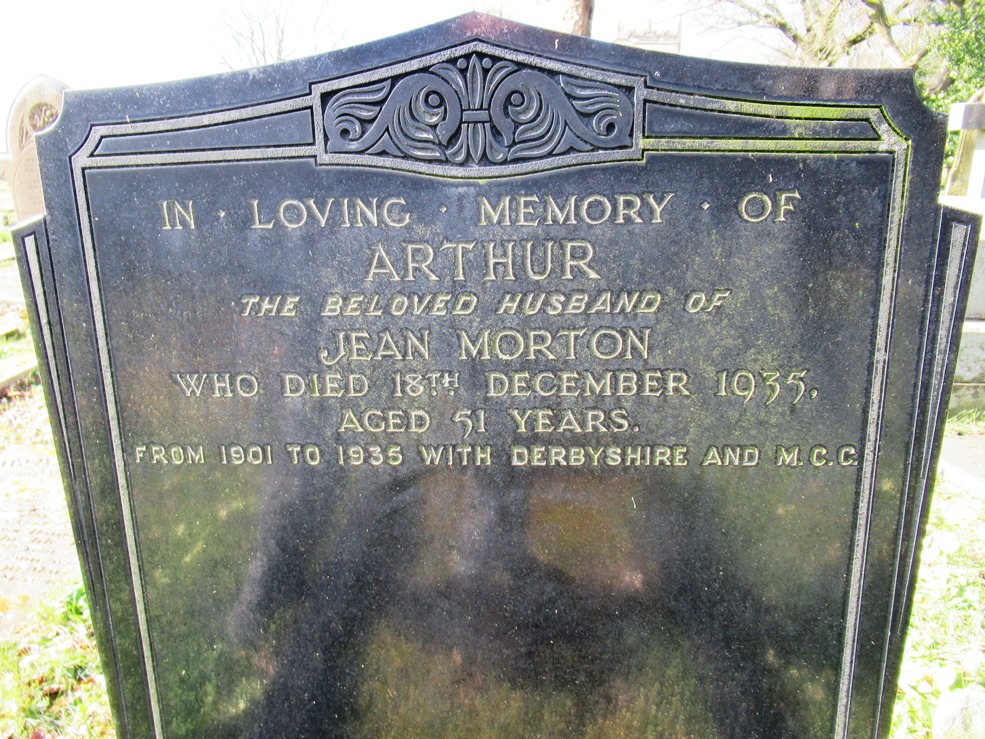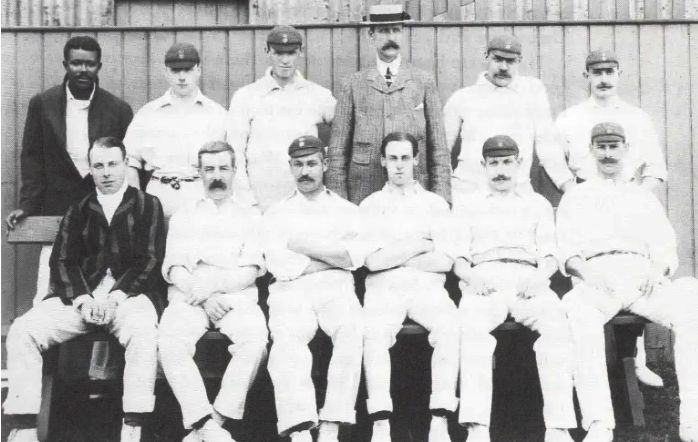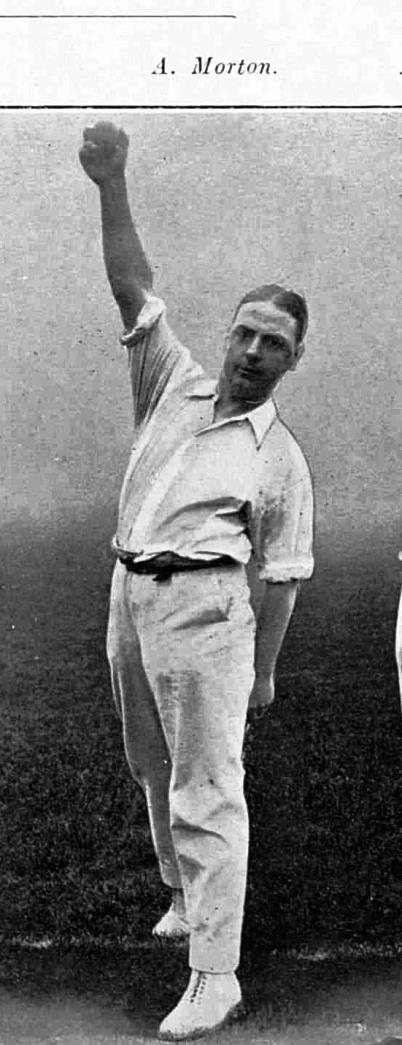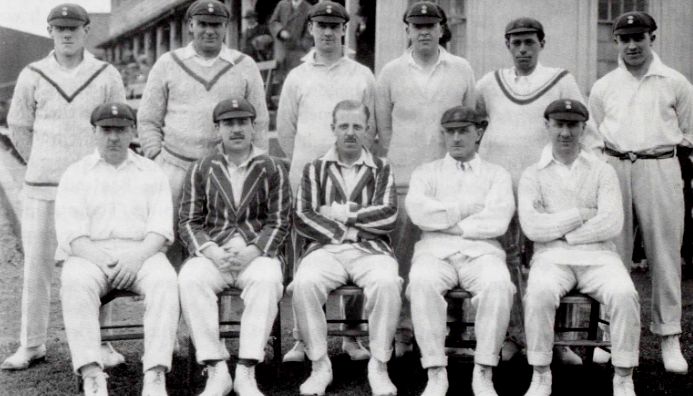In parish burial registers it is very common for a name to be followed by a social rank or occupation. Amongst the records for Mellor's parish church, however, there is a unique entry where the deceased is merely stylised “Cricketer”. This unusual entry is attached to the name of Arthur Morton, a local lad born and brought up in Mellor who went on to become a successful and widely-known professional cricketer in the period often referred to as “Cricket’s Golden Age”. His grave is still prominent in the parish graveyard, his gravestone reminding us of his cricketing career, However, his sporting exploits are now largely forgotten but deserve to be recalled given his contemporary reputation.

Arthur Morton was born on May 7th 1883 and baptised the following January. His father, Thomas, came from a family background of cotton workers and agricultural labourers but he had moved to Mellor [then in Derbyshire] to take employment as a coal miner. Unfortunately, Thomas died when Arthur was only six and his mother then took him and his two sisters to live with their maternal grandfather, Robert Downs, in the cluster of dwellings in Moor End, Mellor known as Sun Dial Cottages. By the time of the 1901 Census, Robert Downs had died and Arthur’s mother was now designated Head of the Household. Arthur was still living at home, then aged 17, but interestingly was said to be “out of employment”. It is likely that he had already made his mark as a promising sportsman with local clubs, especially as a cricketer for Compstall and, later, Glossop, and was devoting his time to that pursuit, possibly with some financial assistance from cricket circles.

Sun Dial Cottages, Mellor
Morton’s real breakthrough to a cricketing career was both unlikely and unexpected. Walter Sugg, a well-known figure in Derbyshire cricket circles with particular associations with the Glossop club, was accustomed to taking a side round the county to play matches against local village teams and he brought a team to play a Marple 14 [not all games were between eleven a side teams in those days]. Morton was not even selected for the Marple and District team but Sugg found his side one short on the day and he invited Morton, already a talented young cricketer with the Compstall club, to play for his team to make up the numbers. It was a great opportunity for him and he took full advantage of the chance. In the game he was top scorer for Sugg’s team making 43 runs out of 120 scored. Then when Marple batted he was brought on to bowl and took ten wickets for just 13 runs, thereby winning the match. Unsurprisingly, as a result, Sugg recommended Morton to Glossop, a more prestigious club playing at a higher level than Compstall and from there he never looked back. After several good performances with bat and ball for Glossop, Morton was recommended to the county by Samuel Wood [later Hill-Wood], a former Captain of Derbyshire. Wood was a member of the wealthy textile family who were deeply involved with cricket and football in Glossop and he later went on to be Chairman of Arsenal football club.

Derbyshire C.C.C in 1906; The aspiring young professional Morton is standing second from the left in the back row.
Morton made his first-class debut for Derbyshire in 1903 and gradually established his place in the county team, becoming a regular from 1905 onwards. He developed into a highly effective all-rounder, bowling off breaks at medium pace and becoming a solid if unspectacular batsman. Over a career of almost twenty seasons, Morton took 981 wickets at a good average and amassed over 10,000 runs. His best bowling performance came in 1911 when he took 9 wickets for 71 runs against Nottinghamshire. That year also saw him make his maiden century, against Hampshire. He made 4 other centuries including his top score of 131 against Essex. His feats made him a great favourite with the Derbyshire cricketing public who appreciated his reliability and fighting qualities, so that the cry of “Good Old Arthur” was often heard at the Derby and Chesterfield grounds. As well as his exploits for Derbyshire, Morton joined the ground staff of the MCC, performing various duties for the members including occasional appearances for the club. He retired at the end of the 1926 season and then was appointed to the first-class umpiring list. Morton remained an umpire until 1935, standing in over 300 matches including one Test Match and several other major fixtures like the annual Gentleman v Players match at Lords.

Both on and off the cricket field Morton was a popular individual whose undemonstrative and steady personality earned widespread respect. Some of his colleagues asked him to be the Best Man at their weddings and he made friends widely in cricketing circles and beyond. When he returned to play for Derbyshire after the Great War, he was asked to “look after” Billy “bad boy” Bestwick, Morton’s tempestuous and volatile colleague whose reputation for misconduct was threatening a promising cricket career. The two became firm friends in the following years.
From the outset Morton’s life had been full of ups and downs. Events of the year 1910 were perhaps the best illustration of this change in fortunes. The year started in the worst possible way for him. In January, he was required to appear in court in New Mills to answer a complaint by Ethel Tymm, a young woman from Mellor. She claimed that Morton was the father of her illegitimate child, that he had reneged on a promise to become engaged and threatened to go to America to get away from her. The alleged intimacy had taken place, it was claimed, on Easter Monday in 1908. The matter had come before Stockport Magistrates the following year but had been dismissed because an alibi had been lodged for Morton demonstrating that he was elsewhere on that day. Ethel Tymm and her family persisted with their case, however, and it came before Derbyshire Magistrates in January 1910. Morton denied all the allegations. After a hearing lasting over four hours the Magistrates decided to make an order in favour of Miss Tymm of 3 shillings and sixpence a week for 16 years with costs. Morton’s barrister immediately gave notice of appeal. Naturally, given Morton’s growing fame in the county, the case created a sensation in the press in Derbyshire and surrounding counties. The absence of any subsequent reports suggests that the matter never went to appeal either due to an out of court settlement or because Morton did not want any further publicity of this sort. At the hearing Morton was supported by many of his fellow professionals and colleagues at the County Council where he was employed in the winter. Consequently, he appears to have kept his popularity and reputation and he bounced back to enjoy his best ever season, achieving the great feat of a hundred wickets in the season, including ten wickets in a match for the first time when playing Hampshire.

Morton in his benefit season, 1924. He is seated on the left of the front row.
Recurring bad luck seems to have been a constant theme in Morton’s life and career. Throughout most of his cricketing career, he had the misfortune to be a member of a weak Derbyshire side. In the 1920 season the county did not win a single match. Consequently, the team was over-dependant on Morton and one or two of his colleagues, not only to bear the brunt of the bowling attack but also to prop up some extremely fragile batting. The strain must have been considerable, not least because match after match saw his fighting efforts come to naught. At the height of his powers when he surely would have gone on to achieve a great deal more, his career was cruelly interrupted by the outbreak of the 1st World War in 1914. Morton joined the Royal Engineers and did not play any serious cricket again until 1919. When Morton was finally accorded the Benefit Match by the county his efforts richly deserved, the game at Chesterfield in 1924 was all but ruined by the weather so he received a relatively paltry sum of two to three hundred pounds. Even off the field his luck was out. In 1921 he accepted a motorcycle ride with Abe Worthington, a member of the Yorkshire team with whom he had become friends. The trip ended in an accident in which Morton sustained injuries including broken ribs which kept him out of cricket for several weeks, a serious issue for a professional sportsman with no rights of salary or sick pay. Even after he retired his misfortunes seem to continue. His umpiring was sufficiently highly respected for him to be selected to stand in a test match between England and the West Indies in 1928 yet he was never asked to officiate in a test match again. No official reason was given but it seems he caused offence to the visiting team by no-balling one of their bowlers during the match and complaints were lodged against him.
Morton continued to umpire at the highest level, however, for several more years. In July 1930, for example, he was selected to officiate in the gentlemen Vs. Players match, once a highlight of the English cricket season. For that match one of the strongest ever Players team had been selected. It included several of the greatest legends from Cricket’s “Golden Age” including Jack Hobbs, Wally Hammond, Frank Woolley and Harold Larwood. Yet sharing the hallowed Lords turf with these great names was a local lad from Mellor who had risen from obscurity through genuine talent and years of committed service to the game.
Yet bad luck continued to hamper Morton’s life to the end. He eventually got married to Jean Coe in 1934 but they only shared a relatively short time together before his death in the following year. The Derby Evening Telegraph reported in May 1935 that Morton had had to undergo an operation but “not a serious one, happily, before he can resume his duties as a first class umpire”. Unfortunately, the newspaper’s optimism was misplaced and Morton’s health continued to deteriorate until his death in December later that year. He had been appointed to the umpire’s list for 1935 but it was a token gesture honouring his long involvement in the game. His death was widely reported in the press and his many cricketing exploits enumerated at some length. It is disappointing therefore that the career of this outstanding sportsman is now largely forgotten. Arthur Morton who rose from unpromising and straightened circumstances in Mellor to become a nationally known and respected figure deserves to be remembered as, in the words of the Derby Daily Telegraph, he was “one of the principal all-rounders Derbyshire has possessed”.
Geoff Higgins - March 2024
Further Reading:
On this website: 'A Crease In History'
Elsewhere: Glossop Cricket Team 1903 - Cricket from the dim and distant past

